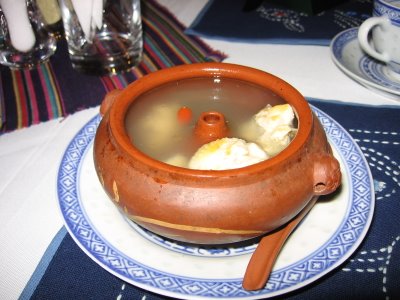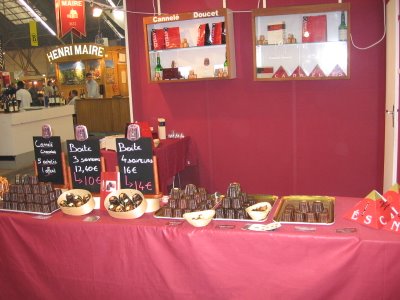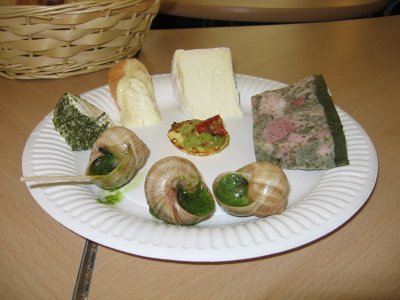Dijon Foire Gastronomique, 2005
You can cut me some slack for posting this four months after the fact since this blog didn't exist when I attended the Foire Gastronomique in Dijon last November. I had known about this venerable food expo (this was the 75th edition) for several years; M.F.K. Fisher writes about it in her memoir of Dijon. I had considered going in 2004, but one of the special features each year is a foreign guest of honor, and in 2004 it was Mexico. Sorry, but no way was I going to France for Mexican food. I did, however, go for Chinese food. When the guest of honor for 2005 was announced as China, I dipped into my vast stockpile of frequent flyer miles and booked a ticket to France post haste. I figured that at a renowned food fair like this I was bound to find regional Chinese cuisine that is otherwise difficult to come by outside of China. Eventually the guest of honor was honed down to Yunnan province, indeed a region whose food is hard to find in the west.
The fair is enormous, one of the largest annual expositions in France, and takes place in a convention center, though originally it happened in tents like fairs of old. Food and wine merchants and restaurants from all over France, as well as other mostly European countries, are represented. One can actually get stuffed on free samples for the 5 Euro price of admission, though there are a quite a few restaurants set up on the premises where one can order a sit-down meal.


I spent a full day at the fair, arriving at noon and calling it a day at 10 PM. My first order of business was to head for the restaurant at the Yunnan pavillion. I quickly--no, slowly--learned that they did not have their act together. It took forever to get service and longer to get food. They had lavishly produced menus, full of photographs and descriptions of the foods of Yunnan, but I discovered that about 80% of the menu was not available. The Yunnan delegation hadn't done proper research, and it turned out that they could not get many of the necessary ingredients. I ended up ordering several appetizers: dumplings which were shaped like Shanghai shao lon bao, but were pan fried and stuffed with a pork and vegetable mixture with plenty of ginger, fried fish filet with a spiced breading, and a chicken soup with Chinese herbs that was served in a cute little ceramic bowl (lead-free, I hope). The food, though good, was a disappointment. My raison d'etre for attending that particular year turned out to be far from the high point of my visit.


Wandering around, I noshed on free samples. How can you not love a place where you are continually being offered tastes of foie gras? Over the course of the day I got smashed on tastes of various wines and aperitifs, some free, some for a modest fee. Among the liquids I consumed, in no particular order, were Alsatian Tokai, grand cru Chablis, grand cru Sauternes, Austrian eiswein, Breton hard cider, a wonderful eau de vie of mirabelle (a French sour plum that is only available one month of the year), and various other wines that are slipping my mind.
I'd say my most treasured discovery of the day was the cannelé, in particular the cannelés of M. Doucet. The cannelé is a traditional Bordelaise pastry, actually a cross between a custard and a pastry, with a moist, fluffy, eggy center and a crisp, caramelized outer crust, the two textures comprising an incredibly sensual gestalt. The pastry is baked in a small mold that gives it the appearance of a mini-bundt cake. As for the flavor, I am at a loss for words, as the taste is sublimely simple and indivisible from the texture. M. Doucet is actually from Normandy, not Bordeaux, and his pastries are probably easier to find in Japan than in France, as he is a partner in chain of successful Tokyo patisseries. While the traditional cannelé is vanilla-flavored, Doucet has added several other varieties, including chocolate, Calvados (in honor of his native region), and green tea (in honor of his cash cow). Doucet's masterpieces were so captivating that when I returned to New York I found myself with an insatiable craving for a cannelé, knowing that if I did find one it would surely be a shadow of Doucet's. Research revealed that three restaurant-affiliated cafes or bakeries offered them: Petrossian, Balthazar and Bouley. The ones at Balthazar were overly sweet and mushy. The ones at Petrossian were quite good, though not in Doucet's league, and their relatively small size made for a less satisfying balance of outer crust and inner bounce. I've yet to try Bouley's.

For a late afternoon snack, at about 4 PM, which, truth be told, I didn't need, I took advantage of a Burgundian sampler, which offered a plate of local specialties and a glass of wine for 6 Euros. The plate consisted of jambon persillé (ham & parsley in aspic), escargots, three cheeses, and something simply called "tapa."

I took a well deserved break from eating and drinking by catching a film at 6 PM. The fair featured an international culinary film festival, and that day there was an English-language film, Peter Greenaway's "The Cook, The Thief, His Wife and Her Lover." I had seen it when it first came out, in 1990, but I had forgotten how pretentious, vapid and nihilistic it was. Surely a film that celebrates boorishness and cannibalism isn't the best choice for an event that encourages consumption. Still, it was good to take a load off my dogs.
At nineish I wrapped up the day with a meal from one of the restaurant concessions, which served specialties of Aubrac, a farming area in southern France. The specialty of Aubrac is aligot, which is a wonderfully heimish mashed potato and cheese concoction made with the tangy, local white tome cheese. On your plate it looks pretty much like mashed potatoes, but it has a dense, delightfully rubbery texture from the cheese, and it's very tasty. It's unclear whether aligot is the side dish or the main course, as it is so central to Aubrac cuisine. Either way, a couple of delicious duck's breast sausages kept my aligot company. This is real country cookin', as stick-to-your-ribs as it gets.
More on Dijon & Burgundy to come.
The fair is enormous, one of the largest annual expositions in France, and takes place in a convention center, though originally it happened in tents like fairs of old. Food and wine merchants and restaurants from all over France, as well as other mostly European countries, are represented. One can actually get stuffed on free samples for the 5 Euro price of admission, though there are a quite a few restaurants set up on the premises where one can order a sit-down meal.


I spent a full day at the fair, arriving at noon and calling it a day at 10 PM. My first order of business was to head for the restaurant at the Yunnan pavillion. I quickly--no, slowly--learned that they did not have their act together. It took forever to get service and longer to get food. They had lavishly produced menus, full of photographs and descriptions of the foods of Yunnan, but I discovered that about 80% of the menu was not available. The Yunnan delegation hadn't done proper research, and it turned out that they could not get many of the necessary ingredients. I ended up ordering several appetizers: dumplings which were shaped like Shanghai shao lon bao, but were pan fried and stuffed with a pork and vegetable mixture with plenty of ginger, fried fish filet with a spiced breading, and a chicken soup with Chinese herbs that was served in a cute little ceramic bowl (lead-free, I hope). The food, though good, was a disappointment. My raison d'etre for attending that particular year turned out to be far from the high point of my visit.


Wandering around, I noshed on free samples. How can you not love a place where you are continually being offered tastes of foie gras? Over the course of the day I got smashed on tastes of various wines and aperitifs, some free, some for a modest fee. Among the liquids I consumed, in no particular order, were Alsatian Tokai, grand cru Chablis, grand cru Sauternes, Austrian eiswein, Breton hard cider, a wonderful eau de vie of mirabelle (a French sour plum that is only available one month of the year), and various other wines that are slipping my mind.
I'd say my most treasured discovery of the day was the cannelé, in particular the cannelés of M. Doucet. The cannelé is a traditional Bordelaise pastry, actually a cross between a custard and a pastry, with a moist, fluffy, eggy center and a crisp, caramelized outer crust, the two textures comprising an incredibly sensual gestalt. The pastry is baked in a small mold that gives it the appearance of a mini-bundt cake. As for the flavor, I am at a loss for words, as the taste is sublimely simple and indivisible from the texture. M. Doucet is actually from Normandy, not Bordeaux, and his pastries are probably easier to find in Japan than in France, as he is a partner in chain of successful Tokyo patisseries. While the traditional cannelé is vanilla-flavored, Doucet has added several other varieties, including chocolate, Calvados (in honor of his native region), and green tea (in honor of his cash cow). Doucet's masterpieces were so captivating that when I returned to New York I found myself with an insatiable craving for a cannelé, knowing that if I did find one it would surely be a shadow of Doucet's. Research revealed that three restaurant-affiliated cafes or bakeries offered them: Petrossian, Balthazar and Bouley. The ones at Balthazar were overly sweet and mushy. The ones at Petrossian were quite good, though not in Doucet's league, and their relatively small size made for a less satisfying balance of outer crust and inner bounce. I've yet to try Bouley's.

For a late afternoon snack, at about 4 PM, which, truth be told, I didn't need, I took advantage of a Burgundian sampler, which offered a plate of local specialties and a glass of wine for 6 Euros. The plate consisted of jambon persillé (ham & parsley in aspic), escargots, three cheeses, and something simply called "tapa."

I took a well deserved break from eating and drinking by catching a film at 6 PM. The fair featured an international culinary film festival, and that day there was an English-language film, Peter Greenaway's "The Cook, The Thief, His Wife and Her Lover." I had seen it when it first came out, in 1990, but I had forgotten how pretentious, vapid and nihilistic it was. Surely a film that celebrates boorishness and cannibalism isn't the best choice for an event that encourages consumption. Still, it was good to take a load off my dogs.
At nineish I wrapped up the day with a meal from one of the restaurant concessions, which served specialties of Aubrac, a farming area in southern France. The specialty of Aubrac is aligot, which is a wonderfully heimish mashed potato and cheese concoction made with the tangy, local white tome cheese. On your plate it looks pretty much like mashed potatoes, but it has a dense, delightfully rubbery texture from the cheese, and it's very tasty. It's unclear whether aligot is the side dish or the main course, as it is so central to Aubrac cuisine. Either way, a couple of delicious duck's breast sausages kept my aligot company. This is real country cookin', as stick-to-your-ribs as it gets.
More on Dijon & Burgundy to come.




2 Comments:
1085? You're older than Methusealh.
Excellent posting, thanks! We heard about this recently, newly living in Paris figured it's a good time to visit Dijon. Merci.
Post a Comment
<< Home